Richard S. Zemel
Wandering Within a World: Online Contextualized Few-Shot Learning
Jul 09, 2020
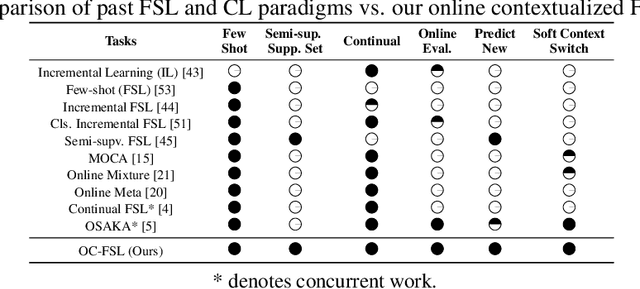


Abstract:We aim to bridge the gap between typical human and machine-learning environments by extending the standard framework of few-shot learning to an online, continual setting. In this setting, episodes do not have separate training and testing phases, and instead models are evaluated online while learning novel classes. As in real world, where the presence of spatiotemporal context helps us retrieve learned skills in the past, our online few-shot learning setting also features an underlying context that changes throughout time. Object classes are correlated within a context and inferring the correct context can lead to better performance. Building upon this setting, we propose a new few-shot learning dataset based on large scale indoor imagery that mimics the visual experience of an agent wandering within a world. Furthermore, we convert popular few-shot learning approaches into online versions and we also propose a new model named contextual prototypical memory that can make use of spatiotemporal contextual information from the recent past.
Efficient Graph Generation with Graph Recurrent Attention Networks
Oct 02, 2019

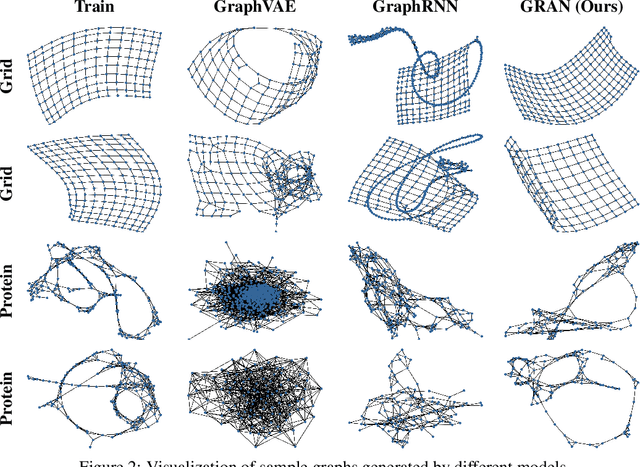
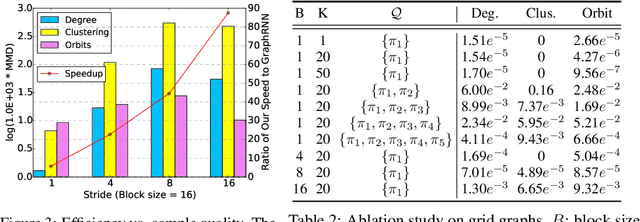
Abstract:We propose a new family of efficient and expressive deep generative models of graphs, called Graph Recurrent Attention Networks (GRANs). Our model generates graphs one block of nodes and associated edges at a time. The block size and sampling stride allow us to trade off sample quality for efficiency. Compared to previous RNN-based graph generative models, our framework better captures the auto-regressive conditioning between the already-generated and to-be-generated parts of the graph using Graph Neural Networks (GNNs) with attention. This not only reduces the dependency on node ordering but also bypasses the long-term bottleneck caused by the sequential nature of RNNs. Moreover, we parameterize the output distribution per block using a mixture of Bernoulli, which captures the correlations among generated edges within the block. Finally, we propose to handle node orderings in generation by marginalizing over a family of canonical orderings. On standard benchmarks, we achieve state-of-the-art time efficiency and sample quality compared to previous models. Additionally, we show our model is capable of generating large graphs of up to 5K nodes with good quality. To the best of our knowledge, GRAN is the first deep graph generative model that can scale to this size. Our code is released at: https://github.com/lrjconan/GRAN.
LanczosNet: Multi-Scale Deep Graph Convolutional Networks
Jan 06, 2019



Abstract:We propose the Lanczos network (LanczosNet), which uses the Lanczos algorithm to construct low rank approximations of the graph Laplacian for graph convolution. Relying on the tridiagonal decomposition of the Lanczos algorithm, we not only efficiently exploit multi-scale information via fast approximated computation of matrix power but also design learnable spectral filters. Being fully differentiable, LanczosNet facilitates both graph kernel learning as well as learning node embeddings. We show the connection between our LanczosNet and graph based manifold learning methods, especially the diffusion maps. We benchmark our model against several recent deep graph networks on citation networks and QM8 quantum chemistry dataset. Experimental results show that our model achieves the state-of-the-art performance in most tasks.
Incremental Few-Shot Learning with Attention Attractor Networks
Oct 16, 2018
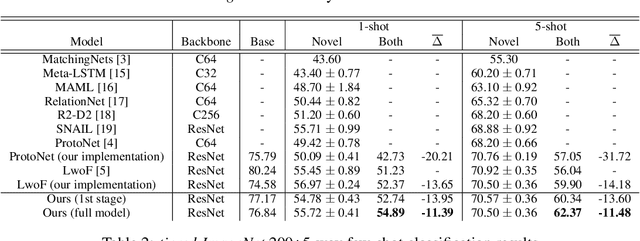


Abstract:Machine learning classifiers are often trained to recognize a set of pre-defined classes. However, in many real applications, it is often desirable to have the flexibility of learning additional concepts, without re-training on the full training set. This paper addresses this problem, incremental few-shot learning, where a regular classification network has already been trained to recognize a set of base classes; and several extra novel classes are being considered, each with only a few labeled examples. After learning the novel classes, the model is then evaluated on the overall performance of both base and novel classes. To this end, we propose a meta-learning model, the Attention Attractor Network, which regularizes the learning of novel classes. In each episode, we train a set of new weights to recognize novel classes until they converge, and we show that the technique of recurrent back-propagation can back-propagate through the optimization process and facilitate the learning of the attractor network regularizer. We demonstrate that the learned attractor network can recognize novel classes while remembering old classes without the need to review the original training set, outperforming baselines that do not rely on an iterative optimization process.
Meta-Learning for Semi-Supervised Few-Shot Classification
Mar 02, 2018

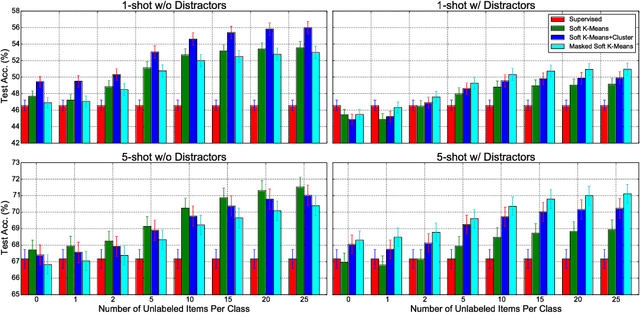

Abstract:In few-shot classification, we are interested in learning algorithms that train a classifier from only a handful of labeled examples. Recent progress in few-shot classification has featured meta-learning, in which a parameterized model for a learning algorithm is defined and trained on episodes representing different classification problems, each with a small labeled training set and its corresponding test set. In this work, we advance this few-shot classification paradigm towards a scenario where unlabeled examples are also available within each episode. We consider two situations: one where all unlabeled examples are assumed to belong to the same set of classes as the labeled examples of the episode, as well as the more challenging situation where examples from other distractor classes are also provided. To address this paradigm, we propose novel extensions of Prototypical Networks (Snell et al., 2017) that are augmented with the ability to use unlabeled examples when producing prototypes. These models are trained in an end-to-end way on episodes, to learn to leverage the unlabeled examples successfully. We evaluate these methods on versions of the Omniglot and miniImageNet benchmarks, adapted to this new framework augmented with unlabeled examples. We also propose a new split of ImageNet, consisting of a large set of classes, with a hierarchical structure. Our experiments confirm that our Prototypical Networks can learn to improve their predictions due to unlabeled examples, much like a semi-supervised algorithm would.
End-to-End Instance Segmentation with Recurrent Attention
Jul 13, 2017



Abstract:While convolutional neural networks have gained impressive success recently in solving structured prediction problems such as semantic segmentation, it remains a challenge to differentiate individual object instances in the scene. Instance segmentation is very important in a variety of applications, such as autonomous driving, image captioning, and visual question answering. Techniques that combine large graphical models with low-level vision have been proposed to address this problem; however, we propose an end-to-end recurrent neural network (RNN) architecture with an attention mechanism to model a human-like counting process, and produce detailed instance segmentations. The network is jointly trained to sequentially produce regions of interest as well as a dominant object segmentation within each region. The proposed model achieves competitive results on the CVPPP, KITTI, and Cityscapes datasets.
Prototypical Networks for Few-shot Learning
Jun 19, 2017



Abstract:We propose prototypical networks for the problem of few-shot classification, where a classifier must generalize to new classes not seen in the training set, given only a small number of examples of each new class. Prototypical networks learn a metric space in which classification can be performed by computing distances to prototype representations of each class. Compared to recent approaches for few-shot learning, they reflect a simpler inductive bias that is beneficial in this limited-data regime, and achieve excellent results. We provide an analysis showing that some simple design decisions can yield substantial improvements over recent approaches involving complicated architectural choices and meta-learning. We further extend prototypical networks to zero-shot learning and achieve state-of-the-art results on the CU-Birds dataset.
Normalizing the Normalizers: Comparing and Extending Network Normalization Schemes
Mar 06, 2017



Abstract:Normalization techniques have only recently begun to be exploited in supervised learning tasks. Batch normalization exploits mini-batch statistics to normalize the activations. This was shown to speed up training and result in better models. However its success has been very limited when dealing with recurrent neural networks. On the other hand, layer normalization normalizes the activations across all activities within a layer. This was shown to work well in the recurrent setting. In this paper we propose a unified view of normalization techniques, as forms of divisive normalization, which includes layer and batch normalization as special cases. Our second contribution is the finding that a small modification to these normalization schemes, in conjunction with a sparse regularizer on the activations, leads to significant benefits over standard normalization techniques. We demonstrate the effectiveness of our unified divisive normalization framework in the context of convolutional neural nets and recurrent neural networks, showing improvements over baselines in image classification, language modeling as well as super-resolution.
Learning to Generate Images with Perceptual Similarity Metrics
Jan 24, 2017


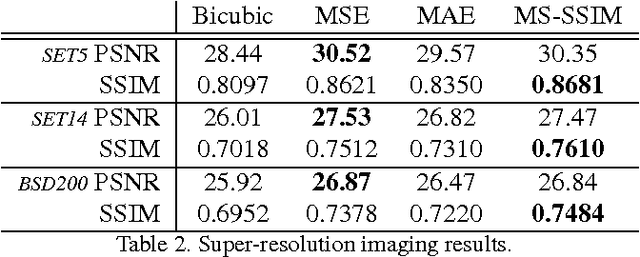
Abstract:Deep networks are increasingly being applied to problems involving image synthesis, e.g., generating images from textual descriptions and reconstructing an input image from a compact representation. Supervised training of image-synthesis networks typically uses a pixel-wise loss (PL) to indicate the mismatch between a generated image and its corresponding target image. We propose instead to use a loss function that is better calibrated to human perceptual judgments of image quality: the multiscale structural-similarity score (MS-SSIM). Because MS-SSIM is differentiable, it is easily incorporated into gradient-descent learning. We compare the consequences of using MS-SSIM versus PL loss on training deterministic and stochastic autoencoders. For three different architectures, we collected human judgments of the quality of image reconstructions. Observers reliably prefer images synthesized by MS-SSIM-optimized models over those synthesized by PL-optimized models, for two distinct PL measures ($\ell_1$ and $\ell_2$ distances). We also explore the effect of training objective on image encoding and analyze conditions under which perceptually-optimized representations yield better performance on image classification. Finally, we demonstrate the superiority of perceptually-optimized networks for super-resolution imaging. Just as computer vision has advanced through the use of convolutional architectures that mimic the structure of the mammalian visual system, we argue that significant additional advances can be made in modeling images through the use of training objectives that are well aligned to characteristics of human perception.
Training Deep Neural Networks via Direct Loss Minimization
Jun 02, 2016



Abstract:Supervised training of deep neural nets typically relies on minimizing cross-entropy. However, in many domains, we are interested in performing well on metrics specific to the application. In this paper we propose a direct loss minimization approach to train deep neural networks, which provably minimizes the application-specific loss function. This is often non-trivial, since these functions are neither smooth nor decomposable and thus are not amenable to optimization with standard gradient-based methods. We demonstrate the effectiveness of our approach in the context of maximizing average precision for ranking problems. Towards this goal, we develop a novel dynamic programming algorithm that can efficiently compute the weight updates. Our approach proves superior to a variety of baselines in the context of action classification and object detection, especially in the presence of label noise.
 Add to Chrome
Add to Chrome Add to Firefox
Add to Firefox Add to Edge
Add to Edge